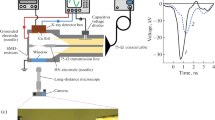Abstract
IN connexion with certain studies of electrical discharges, we have found it necessary to develop an extremely fast shutter for photography. The electro-optic Kerr effect is used. Mounted 5·1 mm. apart in nitrobenzene in a glass Kerr cell, the electrodes are 12·7 mm. wide and 20·3 mm. long. Selected pieces of ‘Polaroid J' film are placed outside the fused-on windows. The cells are subjected to single pulses of about 12,500 volts from a hydrogen thyratron and RLC pulse-forming network, thus admitting light to the lens of an ordinary camera. We have been photographing such intensely self-luminous objects as sparks and electrically exploded wires with exposures of a microsecond or less.
Similar content being viewed by others
Author information
Authors and Affiliations
Rights and permissions
About this article
Cite this article
CADY, W., ZAREM, A. Brief Light Pulses using Kerr Cells. Nature 162, 528–529 (1948). https://doi.org/10.1038/162528b0
Issue Date:
DOI: https://doi.org/10.1038/162528b0
- Springer Nature Limited





